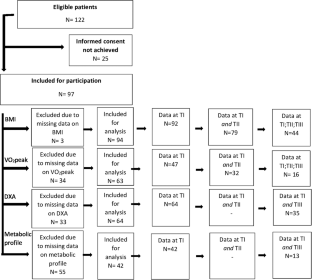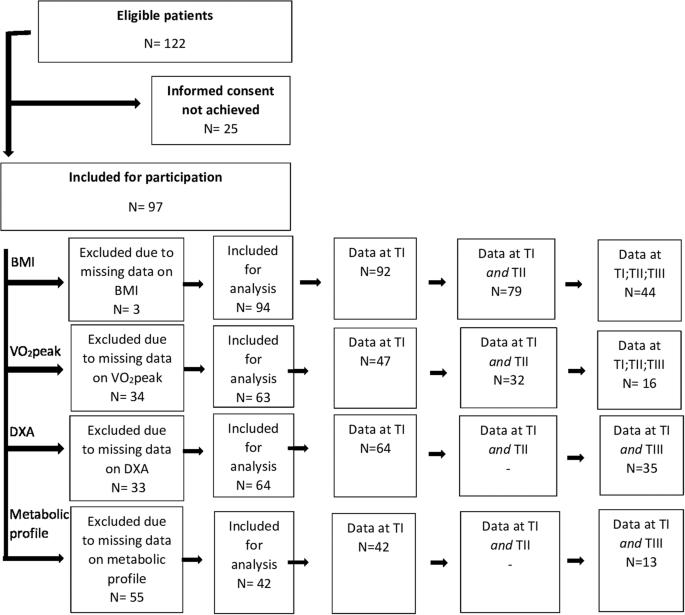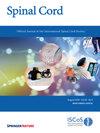Monitoring outcome measures for cardiometabolic disease during rehabilitation and follow-up in people with spinal cord injury
IF 2.1
4区 医学
Q3 CLINICAL NEUROLOGY
引用次数: 0
Abstract
Controlled pragmatic intervention with follow-up. To describe cardiometabolic risk outcomes after a pragmatic intervention implemented into standard spinal cord injury (SCI) rehabilitation. Inpatient SCI rehabilitation in East-Denmark. Inpatients, >18 years, having sustained a SCI within the last 12 months at admission to rehabilitation, regardless of etiology, neurological level or completeness of the lesion or mobility status. Patient education on health promotion was guided by evidence and included feedback on peak oxygen uptake (VO2peak) (primary outcome measure), body mass index (BMI), Dual energy X-ray absorptiometry and metabolic profile (secondary outcome measures). Paired t-tests, non-parametric tests and Analysis of Variance (ANOVA) were used for analyzes. VO2peak and BMI were compared to historical data. VO2peak increased significantly from admission to discharge but did not exceed historical data despite a minimal clinical important difference. BMI decreased significantly during rehabilitation (p < 0.001) followed by a significant increase after discharge (p = 0.006). There was a trend that people with American Spinal Injury Association Impairment Scale (AIS) D SCI increased lean mass to nearly normal values. Criteria for pre-diabetes or diabetes were present in 28.5% and dyslipidemia in 45% of the participants 44.2 days after time of injury. Despite improvements during rehabilitation, outcome measures were worse than recommended, and most outcome measures worsened at follow up, even in people with an AIS D SCI. Meaningful support regarding exercise and diet when tackling altered life circumstances is needed after discharge.


在脊髓损伤患者康复和随访期间监测心脏代谢疾病的结果测量。
研究设计:目标:描述在标准脊髓损伤(SCI)康复中实施实用干预后的心脏代谢风险结果:描述在标准脊髓损伤(SCI)康复中实施实用干预后的心脏代谢风险结果:地点:丹麦东部的脊髓损伤(SCI)康复住院患者:住院患者,年龄在18岁以上,在过去12个月内接受过脊髓损伤康复治疗,无论病因、神经水平、病变的完整性或活动能力状况如何:患者健康促进教育以证据为指导,包括峰值摄氧量(VO2peak)(主要结果测量指标)、体重指数(BMI)、双能X射线吸收测定法和代谢概况(次要结果测量指标)的反馈。分析采用了配对 t 检验、非参数检验和方差分析(ANOVA)。VO2peak 和 BMI 与历史数据进行了比较:结果:从入院到出院,VO2peak 均有明显增加,但未超过历史数据,尽管临床重要差异极小。BMI 在康复期间明显下降(P尽管在康复期间有所改善,但结果指标比建议的要差,而且大多数结果指标在随访时都有所恶化,即使是 AIS D 级 SCI 患者也是如此。出院后,在应对生活环境改变时,需要在运动和饮食方面提供有意义的支持。
本文章由计算机程序翻译,如有差异,请以英文原文为准。
求助全文
约1分钟内获得全文
求助全文
来源期刊

Spinal cord
医学-临床神经学
CiteScore
4.50
自引率
9.10%
发文量
142
审稿时长
2 months
期刊介绍:
Spinal Cord is a specialised, international journal that has been publishing spinal cord related manuscripts since 1963. It appears monthly, online and in print, and accepts contributions on spinal cord anatomy, physiology, management of injury and disease, and the quality of life and life circumstances of people with a spinal cord injury. Spinal Cord is multi-disciplinary and publishes contributions across the entire spectrum of research ranging from basic science to applied clinical research. It focuses on high quality original research, systematic reviews and narrative reviews.
Spinal Cord''s sister journal Spinal Cord Series and Cases: Clinical Management in Spinal Cord Disorders publishes high quality case reports, small case series, pilot and retrospective studies perspectives, Pulse survey articles, Point-couterpoint articles, correspondences and book reviews. It specialises in material that addresses all aspects of life for persons with spinal cord injuries or disorders. For more information, please see the aims and scope of Spinal Cord Series and Cases.
 求助内容:
求助内容: 应助结果提醒方式:
应助结果提醒方式:


